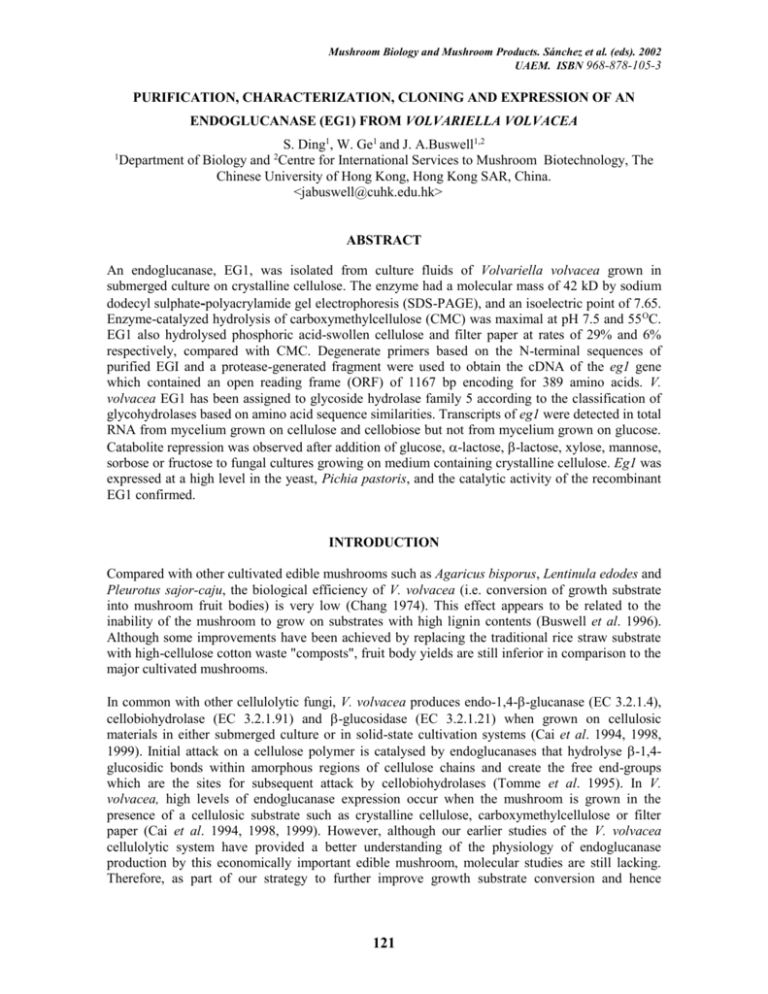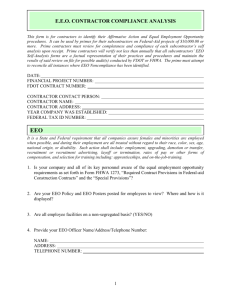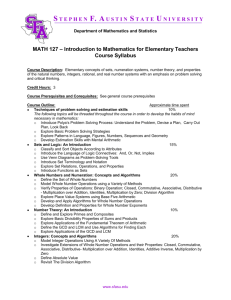(eg1) from volvariella volvacea
advertisement

Mushroom Biology and Mushroom Products. Sánchez et al. (eds). 2002 UAEM. ISBN 968-878-105-3 PURIFICATION, CHARACTERIZATION, CLONING AND EXPRESSION OF AN ENDOGLUCANASE (EG1) FROM VOLVARIELLA VOLVACEA S. Ding1, W. Ge1 and J. A.Buswell1,2 Department of Biology and Centre for International Services to Mushroom Biotechnology, The Chinese University of Hong Kong, Hong Kong SAR, China. <jabuswell@cuhk.edu.hk> 1 2 ABSTRACT An endoglucanase, EG1, was isolated from culture fluids of Volvariella volvacea grown in submerged culture on crystalline cellulose. The enzyme had a molecular mass of 42 kD by sodium dodecyl sulphate-polyacrylamide gel electrophoresis (SDS-PAGE), and an isoelectric point of 7.65. Enzyme-catalyzed hydrolysis of carboxymethylcellulose (CMC) was maximal at pH 7.5 and 55 OC. EG1 also hydrolysed phosphoric acid-swollen cellulose and filter paper at rates of 29% and 6% respectively, compared with CMC. Degenerate primers based on the N-terminal sequences of purified EGI and a protease-generated fragment were used to obtain the cDNA of the eg1 gene which contained an open reading frame (ORF) of 1167 bp encoding for 389 amino acids. V. volvacea EG1 has been assigned to glycoside hydrolase family 5 according to the classification of glycohydrolases based on amino acid sequence similarities. Transcripts of eg1 were detected in total RNA from mycelium grown on cellulose and cellobiose but not from mycelium grown on glucose. Catabolite repression was observed after addition of glucose, -lactose, -lactose, xylose, mannose, sorbose or fructose to fungal cultures growing on medium containing crystalline cellulose. Eg1 was expressed at a high level in the yeast, Pichia pastoris, and the catalytic activity of the recombinant EG1 confirmed. INTRODUCTION Compared with other cultivated edible mushrooms such as Agaricus bisporus, Lentinula edodes and Pleurotus sajor-caju, the biological efficiency of V. volvacea (i.e. conversion of growth substrate into mushroom fruit bodies) is very low (Chang 1974). This effect appears to be related to the inability of the mushroom to grow on substrates with high lignin contents (Buswell et al. 1996). Although some improvements have been achieved by replacing the traditional rice straw substrate with high-cellulose cotton waste "composts", fruit body yields are still inferior in comparison to the major cultivated mushrooms. In common with other cellulolytic fungi, V. volvacea produces endo-1,4--glucanase (EC 3.2.1.4), cellobiohydrolase (EC 3.2.1.91) and -glucosidase (EC 3.2.1.21) when grown on cellulosic materials in either submerged culture or in solid-state cultivation systems (Cai et al. 1994, 1998, 1999). Initial attack on a cellulose polymer is catalysed by endoglucanases that hydrolyse -1,4glucosidic bonds within amorphous regions of cellulose chains and create the free end-groups which are the sites for subsequent attack by cellobiohydrolases (Tomme et al. 1995). In V. volvacea, high levels of endoglucanase expression occur when the mushroom is grown in the presence of a cellulosic substrate such as crystalline cellulose, carboxymethylcellulose or filter paper (Cai et al. 1994, 1998, 1999). However, although our earlier studies of the V. volvacea cellulolytic system have provided a better understanding of the physiology of endoglucanase production by this economically important edible mushroom, molecular studies are still lacking. Therefore, as part of our strategy to further improve growth substrate conversion and hence 121 production efficiency, we have (a) purified and partially characterised an endoglucanase produced by the fungus, and (b) cloned, sequenced and expressed the gene encoding the enzyme. MATERIALS AND METHODS Organisms and growth conditions Volvariella volvacea V14 was obtained from the culture collection of the Centre for International Services to Mushroom Biotechnology located at The Chinese University of Hong Kong (accession no. CMB 002). The fungus was maintained on potato dextrose agar (PDA) at room temperature with periodic transfer. For purification of endoglucanase (EG1), the fungus was grown in 2-litre flasks containing 600 ml basal medium with 1% (w/v) crystalline cellulose (Sigmacell, Type 20) (Ding et al. 2001). The cultures were incubated at 32ºC in an orbital incubator shaker operated at 150 rpm. Conditions used to study induction and catabolite repression of eg1 have been described previously (Ding et al. 2001). E. coli XL1-Blue MRF was used as the host for recombinant plasmids. The E. coli transformants were grown at 37ºC in Luria-Bertani (LB) broth as described previously (Ding et al. 2001), and pBluscript II KS was used to subclone DNA fragments for sequencing. Pichia pastoris strain GS115 was used in the expression study and yeast transformation was performed according to the methods described in the manual, version 3.0, of the EasySelect Pichia Expression Kit (Invitrogen, Carlsbad, CA). Enzyme assay EG1 activity was assayed according to Ding et al. (2001) by measuring the amount of reducing sugar released from carboxymethylcellulose (CMC) (degree of substitution range, 6.5-9 carboxymethyl groups per 10 anhydroglucose units) by the Somogyi-Nelson method using glucose as standard (Somogyi 1952). One unit of enzyme activity is defined as the amount of enzyme that produced one mole of reducing sugar equivalents per minute under the conditions of assay. Specific activity is defined as the number of units per milligram of protein. The molecular weight of purified EG1 was determined by SDS-PAGE (10% w/v acrylamide) according to the method of Laemmli (1970). Isoelectric focusing was performed with enzyme that produced one mole of reducing sugar equivalents per minute under the conditions of assay. Specific activity is defined as the number of units per milligram of protein. Protein determination Protein was determined by the method of Bradford (1976) with bovine serum albumin (BSA) as standard. Protein in column effluents was monitored by measuring A280. Purification and characterisation of EG1 EG1 was purified from 5-day old cultures of V. volvacea using the protocol described by Ding et al. (2001). 122 The molecular weight of purified EG1 was determined by SDS-PAGE (10% w/v acrylamide) according to the method of Laemmli (1970). Isoelectric focusing was performed with the Phastsystem using PhastGel IEF 3-9 operated for 410 Vh. The isoelectric point of the enzyme was determined using standard pI markers (Pharmacia, Uppsala, Sweden). The optimal temperature was determined using the standard assay at temperatures ranging from 35 to 70OC in 0.1 M phosphate buffer, pH 7.5. The optimal pH was determined by the standard assay at 50OC using either 0.1 M phosphate buffer (pH 5.8-8.0) or 0.1M Tris-glycine buffer (pH 8-10). Michaelis-Menten constants were determined from Lineweaver-Burk plots of data obtained by measuring the rate of CMC hydrolysis catalysed by purified EG1 (0.024 U) under the standard assay conditions using a substrate concentration range of 0.1-0.7%. The substrate specificity of purified EG1 was determined at 50OC by measuring the amount of reducing sugar equivalents released after 30-60 min (depending upon the substrate) from various cellulose and xylan preparations as described previously (Ding et al. 2001). Specificity towards p-nitrophenyl- linked glycosides was determined by measuring the amount of p-nitrophenol released from the p-nitrophenyl-linked glycoside as described by Ding et al. (2001). N-terminal amino acid sequencing of intact enzyme and of protease-derived fragments Purified EG1 was electroblotted on to an Immobilon polyvinylidene difluoride (PVDF) Millipore membrane using the LKB Multiblot apparatus (Bio-Rad) as described previously (Matsudaira 1987). The N-terminal amino acid sequence was determined from blotted enzyme by Edman degradation performed with a Hewlett-Packard G1005A Protein Sequencer coupled to a highperformance liquid chromatograph (Hewlett-Packard, Model 1090) for analysis of the phenylthiodantoin amino acids. For internal sequence determinations, partial enzymic proteolysis with Staphylococcus aureus V8 protease was carried out as described previously (Ding et al. 2001). RNA manipulations, cDNA synthesis and cloning. The isolation of total RNA from V. volvacea mycelium, and procedures for obtaining and sequencing full length cDNA clones of eg1 have been described previously (Ding et al. 2001). Northern blot analysis. Expression of eg1 in V. volvacea grown on different carbon sources was analysed with Northern blot as described previously (Ding et al. 2001). Expression of recombinant eg1 in yeast. Transformation and expression of eg1 in P. pastoris was carried out as described previously (Ding et al. 2001) using the expression plasmid pPICZB according to the manufacturer’s protocol (Invitrogen). Nucleotide sequence accession number The nucleotide sequence of the V. volvacea eg1 cDNA has been deposited in the GenBank database and assigned the accession number AF329732. 123 RESULTS Purification and partial characterisation of EG1 EG1 was purified 42-fold, with a 1.5% recovery yield, by ion-exchange chromatography using CMSepharose and gel filtration chromatography with Sephacryl-S100 combined with preparative PAGE (Table 1). Purified EG1 had a molecular mass of 42 kDa by SDS-PAGE, pH and temperature optima of 7.5 and 55OC respectively under the assay conditions used, and an isoelectric point of 7.65. The enzyme hydrolysed CMC, and also phosphoric acid-swollen cellulose and filter paper at 29% and 6%, respectively of the activity observed with CMC. It was not active towards crystalline cellulose (Sigmacell), cotton, oat spelt xylan, birchwood xylan, p-nitrophenyl--D-glucopyranoside, pnitrophenyl--D-cellobioside and 4-methylumbelliferyl--D-cellobioside. CMC hydrolysis by purified EG1 at pH 7.5 and 50OC followed Michaelis-Menten kinetics, and a reciprocal plot revealed an apparent Km value of 0.4% and a Vmax value of 324 moles min-1 mg-1 protein. The Nterminal sequence of native protein and one of internal sequences were determined as NAVPVWGQCGGNGWSGETT and WYHQCQPGAG, respectively. Table 1. Summary of purification protocol for Volvariella volvacea EG1.* Volume (ml) Protein (mg) Total Activity (U) Purification Fold Recovery Yield (%) 4850 Specific Activity (U mg-1) 7.7 Crude Enzyme 135 629 1 100 CM-Sepharose 172 30 1444 48 6.3 30 Sephacryl-S100 Peak 1 Peak 2 122 30 14 1 849 201 59 199 7.7 26 17.5 4.1 Preparative PAGE Peak 2 39 0.22 71 324 42 1.5 *Reprinted from European Journal of Biochemistry, Vol. 268, 5687-5695 (2001), Ding et al. “Endoglucanase 1 from the edible straw mushroom, Volvariella volvacea. Purification, characterization, cloning and expression.” with permission from Blackwell Science Ltd Cloning of full-length cDNA of eg1 The full length eg1 cDNA contained a predicted open reading frame of 1167 bp coding for 389 amino acids (Figure 1). The amino acid sequence from Alanine-24 to Threonine-40 corresponded to the N-terminal sequence of the purified protein, and the sequence from Tryptophan-54 to Proline-64 corresponded to the N-terminal sequence of the protease-generated internal fragment. The putative pre-sequence of 23 amino acids is a hydrophobic signal peptide as predicted by the computer program PLOT. A/ HYD using the method described in (Kyte and Doolittle 1982). The remaining 366 amino acids are considered to constitute the EG1 mature protein. 124 ccatagatccattatgaggtctttgttatcctcagtcgcctctttggcagtcctattcgca M R S L L S S V A S L A V L F A gttgccaagcctgctttggccgccgtcccagtatggggacaatgtggtggcaatggttgg V A K P A L A A V P V W G Q C G G N G W agtggtgaaaccacatgcgcttctggttccacttgtgttgtcgtcaacgaatggtaccac S G E T T C A S G S T C V V V N E W Y H caatgccagcctggcgccggacctacgacaaccagcagcgcacccaaccccacctccagt Q C Q P G A G P T T T S S A P N P T S S ggctgcccgaatgccaccaagttcagattcttcggtgtcaaccaggctggtgctgagttt G C P N A T K F R F F G V N Q A G A E F ggcgagaacgtgatcccaggcgaacttggcacccactacacatggccaagcccaagctcg G E N V I P G E L G T H Y T W P S P S S attgattacttcgttaaccagggcttcaacaccttccgtgtcgcgttcaagattgagcga I D Y F V N Q G F N T F R V A F K I E R ctgagcccaccaggaaccggtctgactggccccttcgaccaggcctacctgaatggtctt L S P P G T G L T G P F D Q A Y L N G L aagacgattgtcaactacattactggcaagaatgcatatgcagtgcttgatccccacaac K T I V N Y I T G K N A Y A V L D P H N tacatgcgttacaatggcaatgtaatcacaagcacctccaacttccagacctggtggaat Y M R Y N G N V I T S T S N F Q T W W N aagctagccaccgaattcaggagcaacacccgtgtcatttttgatgtcatgaacgagcct K L A T E F R S N T R V I F D V M N E P taccaaatcgatgctagcgtcgtcttcaaccttaaccaagctgccatcaatggtatccga Y Q I D A S V V F N L N Q A A I N G I R gctagcggtgctacaagccagctcattcttgtagaaggaactgcatggacaggagcatgg A S G A T S Q L I L V E G T A W T G A W tcttgggaatctagcggaaacggtgcagtcttcggtgccattcgagatcctaacaacaat S W E S S G N G A V F G A I R D P N N N acggccatcgagatgcaccaatacctcgactctgatagttctggtacctctgccacttgc T A I E M H Q Y L D S D S S G T S A T C gtgtcatcgacggttggcgtagagcgtctcagagttgcaactgactggctcaggaggaac V S S T V G V E R L R V A T D W L R R N aacctcaagggcttcctcggtgagatgggtgcagggtccaacgatgtttgcatcgctgct N L K G F L G E M G A G S N D V C I A A gttaagggtgcactttgcgctatgcaacaatctggtgtctggatcggatacttatggtgg V K G A L C A M Q Q S G V W I G Y L W W gcagctggtccatggtggggtacatacttccaatctatcgagcctcccaatggtgcttca A A G P W W G T Y F Q S I E P P N G A S atcgcccgcattctcccagaggctttgaaaccattcgtgtaaaaggcactgtagcctatg I A R I L P E A L K P F V ctgtacctacctccttgtacaacctacaacaatttcgtttcctttaaaaaaaaaaaaaaa aaaaaaaaaaa Figure 1. Nucleotide and deduced amino acid sequences of V. volvacea EG1 Solid line, signal peptide; dashed line, N-terminal sequence; dotted line, internal sequence. Amino acids within the box indicate the cellulose-binding domain. Putative N-glycosylation sites are overlined. Circled residue indicates the putative active site nucleophile of EG1 (Reprinted from European Journal of Biochemistry, Vol. 268, 5687-5695 (2001), Ding et al. “Endoglucanase 1 from the edible straw mushroom, Volvariella volvacea. Purification, characterization, cloning and expression.” with permission from Blackwell Science Ltd). V. volvacea EG1 belongs to family 5 of the over 80 different glycosyl hydrolase families created on the basis of amino acid sequence similarities (Coutinho 2001). In common with other endoglucanases, the enzyme has a cellulose binding domain (CBD) and catalytic domain regions, 125 separated by a linker region rich in serine, threonine and proline (Tomme et al. 1995). The CBD is 36 amino acids long and located at the N-terminal. The presence of four cysteines and four aromatic amino acid residues (3 tryptophan and 1 tyrosine) is characteristic of family I binding domains (Tomme et al. 1995). Alignment of the deduced amino acid sequence of EGI with deduced amino acid sequences of other fungal endoglucanases showed highest overall homology with endoglucanases from Macrophomina phaseolina (53%), Aspergillus niger (52%), Emericella nidulans (52%) and Humicola insolens (51%) (Ding et al. 2001). A 1 2 3 4 5 6 7 8 9 10 eg1 28 S 18 S 2.5 Endoglucanase activity (U/ml) 2 1.5 1 0.5 0 1 2 3 4 5 6 7 8 9 10 Incubation time (days) Figure 2. Time-course of induction of eg1 expression by crystalline cellulose A. Northern blot analysis of eg1 expression. Lanes 1-10 represent the incubation time (1-10 days, respectively) when fungal mycelia were harvested. B. EG1 activity in culture fluids at various time intervals. 126 Transcriptional regulation of eg1 The synthesis of EG1 was regulated both by induction and catabolite repression at the transcriptional level. Transcripts of eg1 were detected by Northern blot in total RNA extracted from mycelium grown on crystalline cellulose over a 10-day culture period (Figure 2A). Extracellular endoglucanase activity in the same cultures appeared to be stable and increased gradually over the 10-day incubation period (Figure 2B). Cellobiose also induced the expression of the eg1 gene in young cultures (1-4 days old) but the intensity of the signal was much weaker than that obtained with cellulose (Figure 3). No eg1 transcripts were detected in total RNA from mycelium grown on glucose (Figure 3). EG1 was also induced within 6 hours following the addition of either 1% (w/v) -lactose, -lactose or cellobiose to cultures of V. volvacea pre-grown in basal medium containing 1% (w/v) sorbitol (Figure 4). Gentiobiose and sophorose were also weak inducers of eg1 transcription under these conditions (Figure 4) although the signal could only be detected after longer exposure times. No induction was observed with xylose, xylitol, mannose, mannitol, galactose, L-arabinose, maltose, -D(+) melibiose or sorbose (Figure 4). Catabolite repression was observed 24 hours following addition of 1% (w/v) glucose, -lactose, lactose, xylose, mannose, sorbose or fructose to V. volvacea cultures grown on basal medium containing 1% (w/v) crystalline cellulose (Figure 5). No catabolite repression was observed with sorbitol, xylitol, mannitol, galactose, L-arabinose, glycerol and glucosamine. 1 2 3 4 5 6 7 8 9 10 eg1 28S 18S Figure 3. Expression of eg1 in medium containing 1% (w/v) cellulose, cellobiose or glucose Total RNA was extracted from V. volvacea mycelium grown on glucose (Lanes 1-4 after 1-4 days incubation, respectively), cellobiose (Lanes 5-8 after 1-4 days incubation, respectively), or cellulose (Lanes 9-10 after 2 and 4 days incubation, respectively). 127 Expression of eg1 in the yeast P. pastoris Heterologous expression of EG1 was achieved in the methylotrophic yeast, Pichia pastoris, using Saccharomyces cerevisiae -factor as signal peptide. The recombinant EG1 was secreted into the medium at high levels (up to 100mg/litre), and was shown by SDS-PAGE to be the major protein in the culture supernatant. The recombinant enzyme had a slightly higher molecular mass (45kDa) than the native enzyme (42kDa). DISCUSSION Efficient breakdown of cellulose requires the cooperative action of at least three classes of enzymes, namely endoglucanases, cellobiohydrolases and -glucosidases, each of which may exist in multiple forms (Knowles et al. 1987, Kubicek 1992). V. volvacea produces a cellulolytic system that includes multiple forms of all three classes when grown on crystalline cellulose (Cai et al. 1994, 1999). In addition to EG1, four other CMC-hydrolysing proteins were separated in lower yields from culture fluids of V. volvacea grown on crystalline cellulose using a combination of hydrophobic interaction chromatography and preparative PAGE (data not shown). However, since SDS-PAGE revealed that all four proteins exhibited the same apparent molecular weight as EG1, and all had identical N-terminal amino acid sequences (eighteen residues) as EG1, we have focused on the biochemical characterisation of EG1 and cloning of the gene encoding for its production. The endo-acting nature of the enzyme is supported by the high activity exhibited by EG1 on CMC and the lack of detectable hydrolysis of crystalline cellulose (Beguin and Aubert 1994). However, EG1 exhibits maximal activity at pH 7.5 which is unusual among fungal endoglucanases, most of which have acidic or neutral pH optima (pH 2.5-7.0) (Clarke 1997). In common with other endoglucanases, EG1 has a cellulose-binding domain (CBD), located at the N-terminal, and a catalytic domain separated by a linker region rich in serine, threonine and proline. Similar CBD sequences have also been identified in two cellobiohydrolases (CBHI and CBHII) produced by V. volvacea although, in the case of CBHI, the putative CBD is located at the Cterminal of the protein (Jia et al. 1999). The CBD of V. volvacea EG1 contains four cysteine residues which, in other fungal CBDs form two disulphide bridges (Kraulis et al. 1989), and conserved aromatic acid residues that are thought to play a key role in binding to the substrate (Reinikeinen et al. 1992). On the basis of homologies and structural comparisons, the active site nucleophile for EG1 is believed to be Glu-324 (Figure 1) (Wang et al. 1993, Mackenzie et al. 1997). The molecular mass of EG1 deduced from the cDNA nucleotide sequence (39.5kDa) is slightly less than the apparent Mr of EG1 purified from V. volvacea cultures (42kDa). This difference is probably due to different glycosylation patterns. Most fungal endoglucanases are glycoproteins, and EG1 contains putative N-glycosylation (Asn-X-Thr/Ser, in which X is not proline) and Oglycosylation sites (Figure 1). In common with cellulases from other cellulolytic fungi, endoglucanase expression in V. volvacea is regulated at the transcriptional level by both induction and catabolite repression (Sachslehner et al. 1998). Expression of the eg1 gene was induced in cultures of V. volvacea grown for up to 96 hours on cellobiose although the level of induction was much lower than that observed with cellulose. Cellobiose has previously been reported to induce endoglucanase expression in both fungal and bacterial systems (Bok et al. 1998, Chikamatsu et al. 1999) although, in some fungal systems, induction is believed to involve the prior conversion to sophorose or gentiobiose. These disaccharides are generated from cellobiose by transglycosylation and are often potent inducers of microbial cellulases (Wood and McCrae 1982, Kurasawa et al. 1992). However, compared to 128 cellobiose, both sophorose and gentiobiose were only very weak inducers of eg1 expression and transglycosylation reactions appear unlikely to play a role in cellobiose-mediated induction of endoglucanase in V. volvacea. Interestingly, the - and isomers of lactose act as both inducers and repressors depending upon the culture conditions (Figure 5). Repression is presumably due to hydrolytic release of glucose from the lactose isomers as fungal growth proceeds. A 1 2 3 4 5 6 7 8 9 10 11 12 13 14 15 eg1 B egl 28 S 18 S Figure 4. Expression of eg1 in V. volvacea mycelia grown in basal medium containing 1% (w/v) sorbitol plus different carbon sources. Total RNA was extracted from mycelium pre-grown on 1% (w/v) sorbitol for 72 hours after which time different carbon sources were added (final concentration 1% w/v) and mycelia were harvested after a further 6 hr (A) or 12 hr (B). Lane 1, sorbitol only; Lanes 2–15, sorbitol plus –lactose, -lactose, cellobiose, xylose, xylitol, mannose, mannitol, galactose, L-arabinose, maltose, -D(+)-melibiose, sorbose, gentiobiose or sophorose, respectively. High level expression and secretion of active recombinant EG1 has been achieved using the methylotrophic yeast, Pichia pastoris, as host. This expression system has been used successfully for the production of a wide range of mammalian, bacterial and fungal proteins (Romanos 1995). Due to their key role in cellulose breakdown, endoglucanases facilitate extensive fungal colonisation of the cellulose-rich cotton-waste growth substrate that is an essential pre-requisite for high fruit body production in V. volvacea. We are now studying how eg1 and other cellulase genes 129 are regulated during the developmental cycle of this fungus as part of a longer-term aim of increasing biological efficiency and improving mushroom yields. 1 2 3 4 5 6 7 8 9 10 11 12 13 14 15 eg1 28 S 18 S Figure 5. Catabolite repression of V. volvacea eg1 by different carbon sources. V. volvacea mycelia were pre-grown on 1% (w/v) cellulose for 5 days. Different carbon sources were then added individually to the cultures and total RNA extracted from fungal mycelia harvested after a further 24 hr incubation. Lane 1: cellulose only; Lanes 2-15: cellulose plus sorbitol, -lactose, -lactose, xylose, xylitol, mannose, mannitol, galactose, L-arabinose, sorbose, glucose, glycerol, fructose or glucosamine, respectively. (Reprinted from European Journal of Biochemistry, Vol. 268, 5687-5695 (2001), Ding et al. “Endoglucanase 1 from the edible straw mushroom, Volvariella volvacea. Purification, characterization, cloning and expression.” with permission from Blackwell Science Ltd ACKNOWLEDGEMENTS This work was supported by Research Grants CUHK 378/95M and CUHK 4080/97M from the Research Grants Council of Hong Kong, and by a Strategic Research Grant from The Chinese University of Hong Kong. REFERENCES Béguin, P. and J. P. Aubert. 1994. The biological degradation of cellulose. FEMS Microbiol. Rev. 13:25-58. Bok, J-D., D.A. Yernool and D.E. Eveleigh. 1998. Purification, characterization, and molecular analysis of thermostable cellulases CelA and CelB from Thermotoga neapolitana. Appl. Environ. Microbiol. 64:47744781. Bradford, M.M. 1976. A rapid and sensitive method for detecting microgram amounts of protein utilizing the principle of protein-dye binding. Anal. Biochem. 72:248-254. Buswell, J.A., Y.J. Cai, S.T. Chang, J.F. Peberdy, S.Y. Fu and H.-S. Yu. 1996. Lignocellulolytic enzyme profiles of edible mushroom fungi. World. J. Microbiol. Biotechnol. 12:537-542. Cai, Y.J., J.A.Buswell and S.T. Chang. 1994. Cellulases and hemicellulases of Volvariella volvacea and the effect of Tween 80 on enzyme production. Mycol. Res. 98:1019-1024. Cai, Y.J., J.A.Buswell and S.T. Chang. 1998. -Glucosidase components of the cellulolytic system of the edible straw mushroom, Volvariella volvacea. Enzyme Microb. Technol. 22:122-129. 130 Cai, Y.J., S.J. Chapman, J.A.Buswell and S.T. Chang. 1999. Production and distribution of endoglucanase, cellobiohydrolase, and -glucosidase components of the cellulolytic system of Volvariella volvacea, the edible straw mushroom. Appl. Environ. Microbiol. 65:553-559. Chang, S.T. 1974. Production of the straw mushroom, (Volvariella volvacea) from cotton wastes. Mushroom J. 21:348-354. Chikamatsu, G., K. Shirai, M. Kato, T. Kobayashi and N. Tsukagoshi. 1999. Structure and expression properties of the endo-beta-1,4-glucanase A gene from the filamentous fungus Aspergillus niger. FEMS Microbiol. Lett. 175:239-245. Clarke, A.J. 1997. Biodegradation of Cellulose:Enzymology and Biotechnology. Lancaster, PA:Technomic Publishing Co. Inc. Coutinho, P. (2001) Glycoside hydrolase families. Website: http://afmb.cnrs-mrs.fr/~pedro/ CAZY/ghf_intro.html Ding, S.J., W. Ge and J.A. Buswell. 2001. Endoglucanase 1 from the edible straw mushroom, Volvariella volvacea Purification, characterization, clonng and expression. Eur. J. Biochem. 268:5687-5695. Jia, J., P.S. Dyer, J.A. Buswell and J.F.Peberdy. 1999. Cloning of the cbhI and cbhII genes involved in cellulose utilisation by the straw mushroom Volvariella volvacea. Mol. Gen. Genet. 261: 985-993. Knowles, J., P.L. Lehtovaara and T. Teeri. 1987. Cellulase families and their genes. Trends Biotechnol., 5:255- 261. Kraulis, P.J., G.M. Clore, M. Nilges, T.A. Jones, G. Pettersson, J. Knowles and A.M. Gronenborn. 1989. Determination of the three-dimensional structure of the C-terminal domain of cellobiohydrolase I from Trichoderma reesei. A study using nuclear magnetic resonance and hybrid distance geometry-dynamical simulated annealing. Biochemistry 28:7241-7257. Kubicek, C.P. 1992. The cellulase proteins of Trichoderma reesei: storage, multiplicity, mode of action and regulation of formation. Adv. Biochem. Engin. Biotechnol. 45:1-27. Kurasawa, T., M.Yachi, M. Suto,Y. Kamagata, S.Takao and F. Tomia. 1992. Induction of cellulase by gentiobiose and its sulfur-containing analog in Penicillium purpurogenum. Appl. Environ. Microbiol. 58:106-110. Kyte, J. and R.F. Doolittle. 1982. A simple method for displaying the hydropathic character of a protein. J. Mol. Biol. 157:105-132. Laemmli, U.K. 1970. Cleavage of structural proteins during the assembly of the head of bacteriophage T4. Nature 227:680-685. Mackenzie, L.F., G.S. Brooke, J.F. Cutfield, P.A.Sullivan and S.G. Withers. 1997. Identification of Glu-330 as the catalytic nucleophile of Candida albicans exo-(-(1,3)-glucanase. J. Biol. Chem. 272:3161-3167. Matsudaira, P. 1987. Sequence from picomole quantities of protein electroblotted onto polyvinylidene diflouride membranes. J. Biol. Chem. 262:10035-10038. Reinikainen, T., L. Ruohonen, T. Nevanen, L. Laaksonen, P. Kraulis, T. Jones, J.K.C. Knowles and T.T. Teeri. 1992. Investigation of the function of mutated cellulose-binding domains of Trichoderma reesei cellobiohydrolase I. Proteins 14:475-482. Romanos, M. 1995. Advances in the use of Pichia pastoris for high-level gene expression. Curr. Biol. 6:527533. Sachslehner, A., B. Nidetzky, K.D. Kulbe and D. Haltrich. 1998. Induction of mannanase, xylanase, and endoglucanase activities in Sclerotium rolfsii. Appl. Environ. Microbiol. 64:594-600. Somogyi, M. 1952. Notes on sugar determination. J. Biol. Chem. 195:19-23. Tomme, P., R.A.J. Warren and N.R. Gilkes. 1995. Cellulose hydrolysis by bacteria and fungi. Adv. Microbial Physiol. 37:3-81. Wang, Q., D. Tull, A. Meinke, N.R. Gilkes, R.A.J. Warren.,R. Aebersold and S.G.Withers. 1993. Glu280 is the nucleophile in the active site of Clostridium thermocellum CelC, a family A endo-(-1,4-glucanase. J. Biol. Chem. 268:14096-14102. Wood, T.M. and S.I. McCrae. 1982. Purification and some properties of the extracellular ß-D-glucosidase of the cellulolytic fungus Trichoderma koningii. J. Gen. Microbiol. 128:2973-2982. 131







